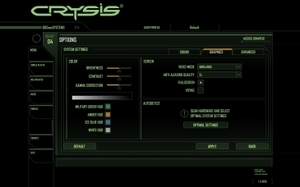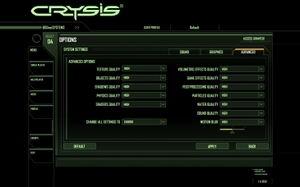
Crysis
Publisher: Electronic ArtsWe patch Crysis to v1.21 and run it in DirectX 10 mode with High detail settings at the native resolution of the laptop's screen with 2x AA and no AF to give a reasonably real-world test.
We load a save game in the Relic level and play the game for roughly three minutes, following a strictly defined sequence of actions and movements. We repeat this test three times, or until a reliable set of results is achieved. The consistent results are then averaged to give the figures below.
This is the best way to test how the CPU and GPU affects game performance, as the game will be generating AI and physics and game rules for the CPU to perform. A timedemo addresses a CPU in a noticeably different way.
Fallout 3
Publisher: BethesdaFallout 3 is the revival of Interplay’s excellent Fallout series of games following many years out of the limelight. It’s developed and published by Bethesda and, judging by the success of the game, we’ll be seeing more Fallout games in the future.
Despite using the Oblivion engine which is now a few years old, the game looks absolutely stunning. Bethesda has spiced up the graphics a bit since Oblivion and has extended the engine – there are some great explosions, soft shadows and smoke effects that are particularly noteworthy.
We tested the game by manually playing a section of the game that incorporates a number of explosions and effects that you’re likely to experience during your time in post-apocalyptic Washington DC. We recorded the frame rate using FRAPS.
The in-game details were set to their highest values and both anti-aliasing and anisotropic filtering were controlled by the application settings instead of through the driver control panel. This meant that transparency anti-aliasing was enabled, along with HDR and all of the cool smoke effects.
Fallout 3’s engine is by default capped to 60 frames per second, which can make benchmark results very unclear, especially when testing at lower resolutions or with high end graphics cards. To remove the 60FPS cap you’ll need to find the Fallout3.ini file in \Documents\My Games\Fallout3 and edit the file so that iPresentInterval=0. This removes the frame rate cap, and allows us to get a much better idea of a product’s abilities.
Race Driver: GRID
Publisher: CodemastersRace Driver: GRID is one of the best racing games to grace the PC in some time, striking a fine balance between automotive simulation and arcade throttle-fest which has resulted in an enormously entertaining game. Players can choose from racing tuned saloons through city streets, through to driving Lamborghinis around Le Mans, with all cars displaying a highly detailed damage model.
GRID runs on a modified version of Codemasters' own in house Neon engine, rechristened Ego for GRID. This will also be the engine used in the highly anticipated Operation Flashpoint 2: Dragon Rising, so hopefully GRID will give us a good indication of how hardware will perform in this future title too. Despite only supporting DirectX 9.0c, GRID features a lot of high level graphical features, including motion blur, fantastic smoke effects, dynamic track side details and thousands of fully 3D spectators.
To test performance in GRID, we raced a lap of the "San Francisco Short Circuit" track in the RADT Nissan Skyline Z-tune, starting from the back of the grid to ensure as many cars on screen for as long as possible. We chose the San Francisco circuit due to the large amount of dynamic track side details like flags and spectators visible from the track, and for the close proximity of track side objects.
As you can see, we tested the G60Vx with three games at its native screen resolution – GRID, Fallout 3 and Crysis. GRID is the easiest of the three in terms of its hardware demands, but it’s still a great looking title, and a good indicator of a non-FPS, cross-platform game. At 1,366 x 768, with 4x MSAA applied, it whipped along on the G60Vx at a brisk 51fps average. More importantly, it dipped to only 40fps while we were racing, so remained smooth and enjoyable.
At the same settings, Fallout 3 did dip below 25fps with a minimum of 23fps. As it’s a slower paced game than GRID, you might find this acceptable, especially with a strong average of 45fps. Otherwise, dropping from 4x AA and 16x AF to lower settings should help you other.
Crysis has a reputation of being a PC breaker, and so it proved; at 1,366 x 768 with 2x AA, the framerates were dramatically lower than the other games, with a stuttery 15fps minimum and 22fps average. You’ll need to remove the AA and drop key detail settings to medium to boost the game’s speed.
Essentially then, the low screen resolution suits the ageing technology in the GPU, and certainly when it comes to games that have also been released on the Xbox 360, the G60Vx has what it takes to power them at a decent pace. The games look fine, too, although obviously if you're used to gaming on higher resolution desktop screen, 1,366 x 768 is probably going to lack the crispness you're used to.
While the G60Vx's graphical power is fine in and of itself, no product stands in isolation, and the GTX 260M's big problem is ATI's Mobility Radeon HD 4850. We had limited time with an MSI laptop using this GPU, the GT725. It uses the HD 4850, and despite having only 512MB RAM, proved slightly quicker in Crysis, and was the G60Vx's equal in GRID. The MSI posted a minimum framerate of 42fps at its native resolution of 1,680 x 1,050 - virtually identical to the G60Vx, despite the fact the latter has a lower resolution panel. As is the case at many price points on the desktop, it seems ATI and Nvidia are level pegging here.

MSI MPG Velox 100R Chassis Review
October 14 2021 | 15:04










Want to comment? Please log in.